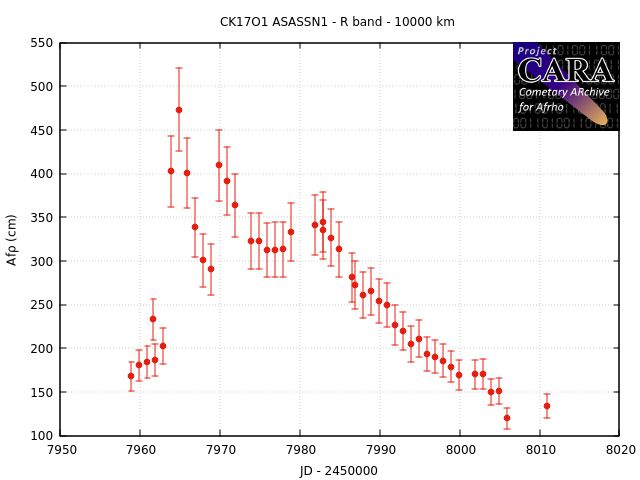What is happening to C/2017 O1 (ASASSN)?
| Attachment | Size |
|---|---|
| cara news 1-C2017 O1.pdf | 171.52 KB |

Comet C/2017 O1 (ASASSN) was discovered on July 19 displaying already a large diffuse gas coma in the following days. This color image was taken by Rolando Ligustri on July 27, the green color of the coma is due to the presence of strong C2 emission bands in the spectrum.
Comet C/2017 O1 (ASASSN) is a new good interesting target well placed for northern observers. Inner forecasts predicts that the total magnitude should peaks around 8 around perihelion in mid October. But its behavior is very uncertain because the comet, close to magnitude 15 at the discovery, displayed some moderate amplitude outbursts, and very likely it was also in outburst at the discovery between July 19 and 22.
The CARA (Cometary ARchive for Afr consortium) is now going to monitor the evolution of the comet in the upcoming weeks. What is going to happen around perihelion is an open question.
The Af[rho] plot shows two distinct outbursts on July 22-29 and on August 4. An apparent small brightening (a small outburst?) occurred also around August 14 followed by a fading.

Early photometric observations from the CARA consortium highlight an unusual behavior characterized by two (or perhaps three) small outbursts. The Af[rho] plot clearly shows the evolution of the two main outbursts peaking to 400 - 500 cm. The Af[rho] quantity (a proxy for dust production rate) refers to R band photometry and to a 10,000 km radius measuring window at the comet. The observations in R photometric band are provided by Erik Bryssinck, Franz-Josef Hambsch, Rolando Ligustri, Daniele Carosati, Adriano Valvasori.
Erik Bryssinck
Dario Castellano
Giannantonio Milani
Adriano Valvasori
- Login to post comments
